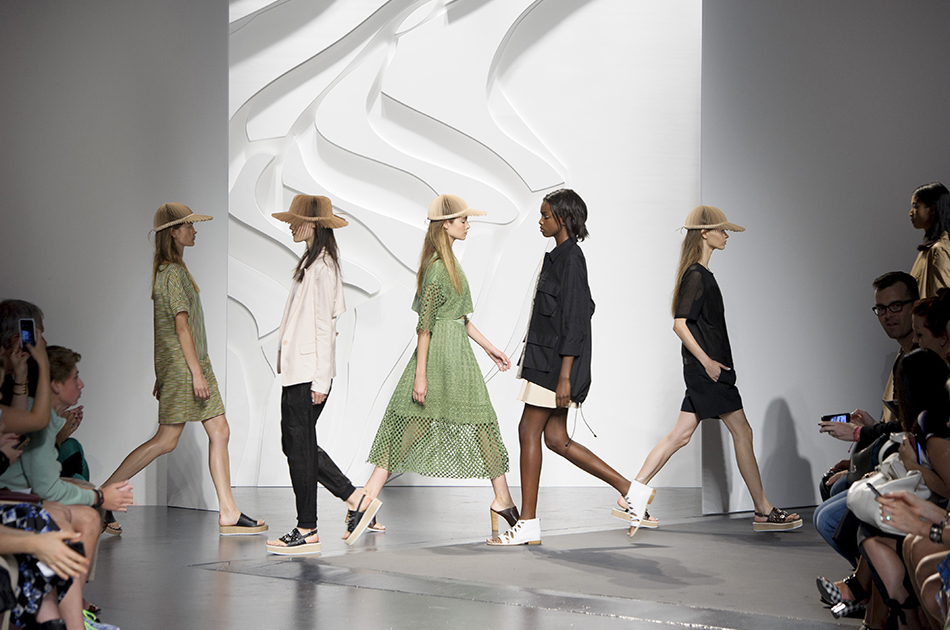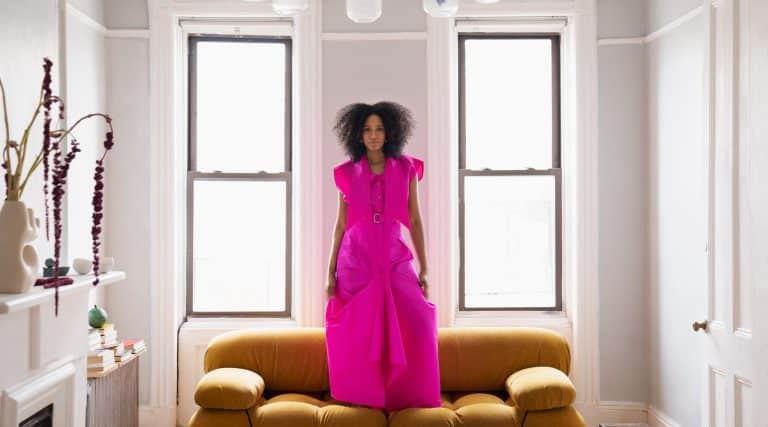
February 5, 2014An image from Tibi’s Spring 2014 campaign spotlights several of the attributes — clean lines, for example, and bright colors — for which the brand is best known. Top: The company’s founder, Amy Smilovic, poses in downtown Manhattan, where Tibi is based. All images © Tibi
Tibi. Say it aloud: tih-bee. It’s a name that rolls cheerily off the tongue. Catchy and neat, perky even, it is the perfect sonic equivalent of Amy Smilovic’s clothing line, celebrated for its clean lines, pops of color (like dots on an “i”) and graphic prints.
Born into a family of artists on St. Simons Island, Georgia, Smilovic is naturally creative, whether she’s sketching a look for her line, building a business plan or decorating her home in Greenwich, Connecticut. The designer, a one-time ad exec, launched Tibi in 1997, when she was living in Hong Kong. Since 2000, the company has been based in New York’s Noho, the downtown location complementing the brand’s easy-going, eye-catching aesthetic.
In Greenwich, meanwhile, she lives in leafy tranquility with her husband, Frank, the president of Tibi, their two sons, ages 10 and 13, a toy poodle and a rather talkative cat. The house’s traditional exterior belies a minimal, yet welcoming interior, full of bright colors and contrasts, which Smilovic created with New York interior designer Bruce Shostak. Her inspiration? The then-current Fall 2010 runway collections. Thus the formal living room took its cue from Marc Jacobs, the master bedroom from Chloe and so on. “It’s a good way to see colors and how they’re all put together in an interesting way,” says the designer. “I think if you are just taking swatches and putting them together, it’s hard to start from that open of a place. It helps if you have a visual.” Like her clothing line, Smilovic designed the house both for style and comfort. “I wanted something that was a bit refined but friendly — a place that the whole family feels comfortable coming home to at the end of the day.”
On the eve of her February 8 runway show at New York Fashion Week, 1stdibs’ Laird Persson spoke to Smilovic about accessorizing, her source for home design and the one that got away.

As with her clothing label, Smilovic embraced color for her Greenwich, Connecticut, home, outfitting a bathroom in red Donghia wallpaper.
What’s your first fashion memory?
My first real fashion memory is of Sonia Jordan, my third-grade classmate who had these pink jeans that were studded with palm trees. And there was this guy Cameron, and Cameron loved Sonia, and I was convinced it was because of the jeans — not because she was half Indian and had long, beautiful black hair and was gorgeous. It was the jeans. So I convinced my parents to buy me pink jeans and my dad, who’s an artist, painted palm trees on them because we didn’t have a stud gun. And I showed up at school in those jeans and sat down right next to Sonia. But I never got Cameron.
How did you get your start?
I was that kid who had the newspaper route at ten. I had not just a lemonade stand, but a chain of lemonade stands, and I didn’t just babysit, I franchised it. I was always starting businesses, and, coming from a family of artists, I wanted to merge that with creativity and art.
When I started Tibi, it was very much about identifying an opportunity in the market at the time. But now I would describe myself as obsessed with fashion and design, and I operate much more from that point of view than from a business perspective.
“When I started Tibi, it was very much about identifying an opportunity in the market at the time. But now I would describe myself as obsessed with fashion and design.”
What was your first big break?
Being picked up by Lane Crawford. And then Jeannine Braden of Fred Siegel saw these little bias-cut skirts that I had done and said: “If you did these in great prints I would buy tons of them for Fred Siegel.” So I scoured Hong Kong, where I was living at the time, and found all these really tacky knock-off Hermès scarves. And then in New York, I found postcard-print scarves in a vintage market on Bleecker Street. And I took all these scarves and had my printing mill recreate them. We thought: They are so tacky that they kind of work. Some time later, I opened up the New York Times on a Sunday morning, and every single photograph by Bill Cunningham was of a woman in one of my skirts. It was a breakthrough moment.
Is your approach to creating home and store environments similar?
There’s probably a lot of similarity — the company is so me right now that I can’t separate them. I really do like to change things up a lot. I just feel very uneasy when things are the same all the time. All that plastic and high gloss and acrylic — that Pop Art-type look feels so ubiquitous to me right now. It’s one thing to be wearing the same dress that someone else is wearing, but to be wearing the same house?

Smilovic, at home in head-to-toe Tibi, stands near a vintage chaise covered in Madeline Weinrib fabric.
Where do you shop for your home?
Irwin Feld in Stamford, Connecticut. I found him on 1stdibs. It’s all mid-century modern.
You take your design team to Paris after your fashion show — what’s your favorite Parisian spot?
L’As du Fallafel, on the rue des Rosiers. It’s these Israeli guys and the best falafel in the whole world and eight-dollar bottles of wine.
Tell me about your fall 2014 Collection, debuting this week.
This collection tells of the unlikely, provocative intersection of the pastoral and the urban. Through a Magritte-esque play with reality and illusion, the collection creates a world where nature and city, the soft and the austere, can coexist.










